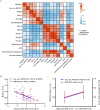Interaction Between DHCR24 and hsa_circ_0015335 Facilitates Cognitive Impairment in Cerebral Small Vessel Disease Patients
- PMID: 39578712
- PMCID: PMC11584349
- DOI: 10.1111/cns.70131
Interaction Between DHCR24 and hsa_circ_0015335 Facilitates Cognitive Impairment in Cerebral Small Vessel Disease Patients
Abstract
Aims: The study attempted to determine the underlying role and regulation mechanism of 3β-hydroxysterol-Δ24 reductase (DHCR24) in the pathophysiology of cerebral small vessel disease-associated cognitive impairment (CSVD-CI). An RNA high-throughput sequencing and independent verification were conducted to identify potential circRNAs becoming the upstream regulator.
Methods: RNA sequencing was performed in whole-blood samples in cohort 1 (10 CSVD-CI and 8 CSVD with cognitively normal [CSVD-CN] patients). The DHCR24 and candidate circRNAs were verified in an independent cohort 2 (45 CSVD-CI participants and 37 CSVD-CN ones). The study also analyzed comprehensive cognitive assessments, plasma molecular index, and brain structure imaging.
Results: The expression of DHCR24 and has_circ_0015335 in whole-blood samples of CSVD-CI patients was significantly reduced compared to CSVD-CN patients in RNA sequencing and independent verification. Furthermore, the levels of DHCR24 and has_circ_0015335 were significantly related to global cognitive impairment in CSVD-CI patients. Meanwhile, DHCR24 could regulate the correlation between has_circ_0015335 expression and alterations in brain cortex in surface area, thickness, and volume in CSVD-CI patients. Additionally, hsa_circ_0015335 interacted with DHCR24 for plasma 24(S)-hydroxycholesterol levels among CSVD-CI patients.
Conclusion: Interaction between DHCR24 and hsa_circ_0015335 cognitively impaired CSVD by affecting brain cholesterol metabolism and brain structural changes.
Keywords: brain magnetic resonance imaging; cerebral small vessel disease; cholesterol metabolism; circRNA; cognitive impairment; mRNA.
© 2024 The Author(s). CNS Neuroscience & Therapeutics published by John Wiley & Sons Ltd.
Conflict of interest statement
The authors declare no conflicts of interest.
Figures




Similar articles
-
DHCR24 is an independent predictor of progression in patients with non-muscle-invasive urothelial carcinoma, and its functional role is involved in the aggressive properties of urothelial carcinoma cells.Ann Surg Oncol. 2014 Dec;21 Suppl 4:S538-45. doi: 10.1245/s10434-014-3560-6. Epub 2014 Feb 22. Ann Surg Oncol. 2014. PMID: 24562935
-
Association of Mean Upper Cervical Spinal Cord Cross-Sectional Area With Cerebral Small Vessel Disease: A Community-Based Cohort Study.Stroke. 2024 Mar;55(3):687-695. doi: 10.1161/STROKEAHA.123.044666. Epub 2024 Jan 25. Stroke. 2024. PMID: 38269540
-
Circular RNA Expression of Peripheral Blood Mononuclear Cells Associated with Risk of Acute Exacerbation in Smoking Chronic Obstructive Pulmonary Disease.Int J Chron Obstruct Pulmon Dis. 2024 Mar 20;19:789-797. doi: 10.2147/COPD.S448759. eCollection 2024. Int J Chron Obstruct Pulmon Dis. 2024. PMID: 38524397 Free PMC article.
-
The global burden of cerebral small vessel disease in low- and middle-income countries: A systematic review and meta-analysis.Int J Stroke. 2023 Jan;18(1):15-27. doi: 10.1177/17474930221137019. Epub 2022 Nov 25. Int J Stroke. 2023. PMID: 36282189
-
Antithrombotic therapy to prevent cognitive decline in people with small vessel disease on neuroimaging but without dementia.Cochrane Database Syst Rev. 2022 Jul 14;7(7):CD012269. doi: 10.1002/14651858.CD012269.pub2. Cochrane Database Syst Rev. 2022. PMID: 35833913 Free PMC article.
Cited by
-
Treatment of Pathological Lymphangiogenesis via Circular RNA-Mediated Cholesterol Metabolism Remodeling.Invest Ophthalmol Vis Sci. 2025 Apr 1;66(4):26. doi: 10.1167/iovs.66.4.26. Invest Ophthalmol Vis Sci. 2025. PMID: 40214644 Free PMC article.
References
-
- Wang J., Zhang Y., Tian N., et al., “Mechanisms of Glutamate Metabolic Function and Dysfunction in Vascular Dementia,” Neuroprotection 2 (2024): 33–48, 10.1002/nep3.32. - DOI
Publication types
MeSH terms
Substances
Grants and funding
- JSSCBS20221995/Jiangsu province double-creation doctoral talent plan
- 2021THRC-TF-YXYXK/the Medical Expert Team Program of Wuxi Taihu Talent Plan 2021
- Q202222/the WuXi Municipal Health Commission
- 82301715/National Natural Science Foundation of China
- 2020THRC-DJ-SNW/Wuxi Taihu Lake Talent Plan, Supports for Leading Talents in Medical and Health Profession
LinkOut - more resources
Full Text Sources
Medical

